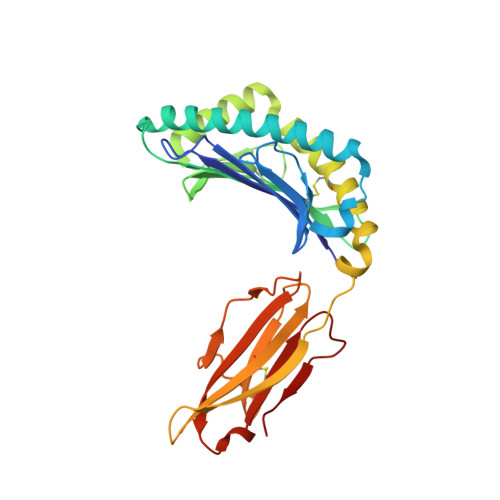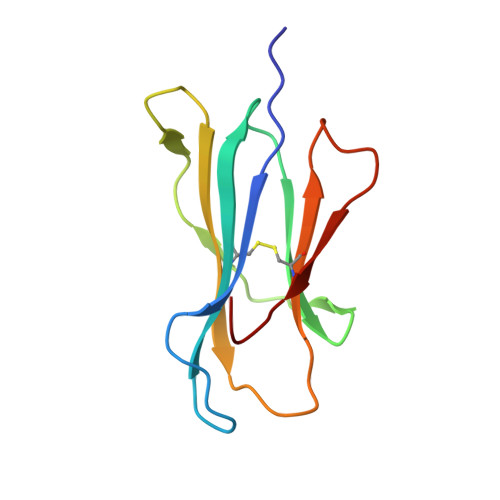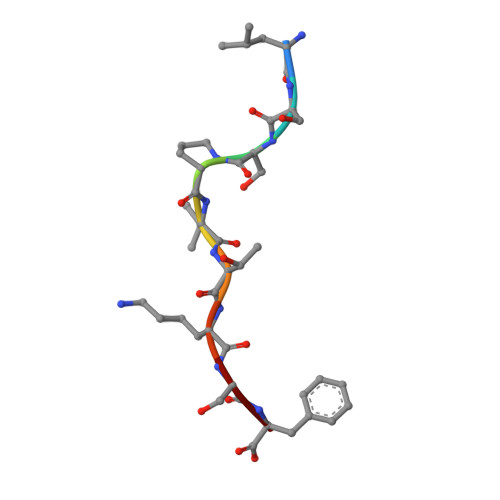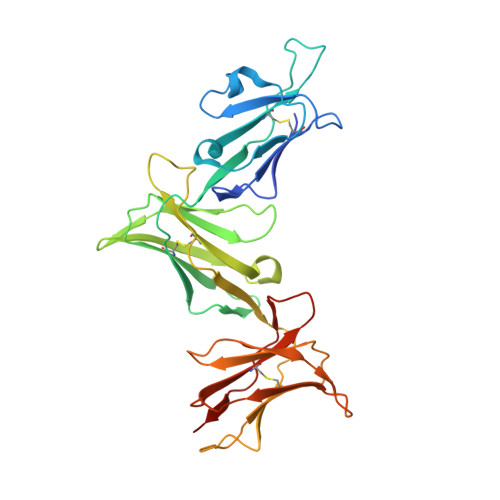6V3J
KIR3DL1 in complex with HLA-B*57:03 presenting the peptide LSSPVTKSF
- PDB DOI: https://doi.org/10.2210/pdb6V3J/pdb
- Classification: IMMUNE SYSTEM
- Organism(s): Homo sapiens, synthetic construct
- Expression System: Escherichia coli BL21, Trichoplusia ni
- Mutation(s): No
- Deposited: 2019-11-25 Released: 2020-05-20
Experimental Data Snapshot
- Method: X-RAY DIFFRACTION
- Resolution: 1.98 Å
- R-Value Free: 0.236
- R-Value Work: 0.191
- R-Value Observed: 0.193
wwPDB Validation 3D Report Full Report
Currently 6V3J does not have a validation slider image.
This is version 1.4 of the entry. See complete history.
Macromolecules
Find similar proteins by:
(by identity cutoff) | 3D Structure
Entity ID: 1 | |||||
|---|---|---|---|---|---|
| Molecule | Chains | Sequence Length | Organism | Details | Image |
| HLA-B alpha chain (B*5703GB) | 275 | Homo sapiens | Mutation(s): 0 Gene Names: HLA-B, HLA-B*5703GB |  | |
UniProt | |||||
Find proteins for I3ZN84 (Homo sapiens) Explore I3ZN84 Go to UniProtKB: I3ZN84 | |||||
Entity Groups | |||||
| Sequence Clusters | 30% Identity50% Identity70% Identity90% Identity95% Identity100% Identity | ||||
| UniProt Group | I3ZN84 | ||||
Sequence AnnotationsExpand | |||||
| |||||
Find similar proteins by:
(by identity cutoff) | 3D Structure
Entity ID: 2 | |||||
|---|---|---|---|---|---|
| Molecule | Chains | Sequence Length | Organism | Details | Image |
| Beta-2-microglobulin | 100 | Homo sapiens | Mutation(s): 0 Gene Names: B2M, CDABP0092, HDCMA22P |  | |
UniProt & NIH Common Fund Data Resources | |||||
Find proteins for P61769 (Homo sapiens) Explore P61769 Go to UniProtKB: P61769 | |||||
PHAROS: P61769 GTEx: ENSG00000166710 | |||||
Entity Groups | |||||
| Sequence Clusters | 30% Identity50% Identity70% Identity90% Identity95% Identity100% Identity | ||||
| UniProt Group | P61769 | ||||
Sequence AnnotationsExpand | |||||
| |||||
Find similar proteins by: Sequence | 3D Structure
Entity ID: 3 | |||||
|---|---|---|---|---|---|
| Molecule | Chains | Sequence Length | Organism | Details | Image |
| Peptide Leu-Ser-Ser-Pro-Val-Thr-Lys-Ser-Phe | 9 | synthetic construct | Mutation(s): 0 |  | |
Sequence AnnotationsExpand | |||||
| |||||
Find similar proteins by:
(by identity cutoff) | 3D Structure
Entity ID: 4 | |||||
|---|---|---|---|---|---|
| Molecule | Chains | Sequence Length | Organism | Details | Image |
| Killer cell immunoglobulin-like receptor 3DL1 | D [auth G] | 299 | Homo sapiens | Mutation(s): 0 Gene Names: KIR3DL1, CD158E, NKAT3, NKB1 |  |
UniProt & NIH Common Fund Data Resources | |||||
Find proteins for P43629 (Homo sapiens) Explore P43629 Go to UniProtKB: P43629 | |||||
PHAROS: P43629 GTEx: ENSG00000167633 | |||||
Entity Groups | |||||
| Sequence Clusters | 30% Identity50% Identity70% Identity90% Identity95% Identity100% Identity | ||||
| UniProt Group | P43629 | ||||
Sequence AnnotationsExpand | |||||
| |||||
Small Molecules
| Ligands 1 Unique | |||||
|---|---|---|---|---|---|
| ID | Chains | Name / Formula / InChI Key | 2D Diagram | 3D Interactions | |
| NAG (Subject of Investigation/LOI) Query on NAG | E [auth G], F [auth G], G | 2-acetamido-2-deoxy-beta-D-glucopyranose C8 H15 N O6 OVRNDRQMDRJTHS-FMDGEEDCSA-N |  | ||
Experimental Data & Validation
Experimental Data
- Method: X-RAY DIFFRACTION
- Resolution: 1.98 Å
- R-Value Free: 0.236
- R-Value Work: 0.191
- R-Value Observed: 0.193
- Space Group: P 1
Unit Cell:
| Length ( Å ) | Angle ( ˚ ) |
|---|---|
| a = 51.759 | α = 96.65 |
| b = 60.771 | β = 97.39 |
| c = 65.36 | γ = 109.18 |
| Software Name | Purpose |
|---|---|
| PHENIX | refinement |
| XDS | data reduction |
| Aimless | data scaling |
| PHASER | phasing |
Structure Validation
Currently 6V3J does not have a validation slider image.
Entry History
Deposition Data
- Released Date: 2020-05-20 Deposition Author(s): Maclachlan, B., Rossjohn, J., Vivian, J.P.
Revision History (Full details and data files)
- Version 1.0: 2020-05-20
Type: Initial release - Version 1.1: 2020-05-27
Changes: Database references - Version 1.2: 2020-06-10
Changes: Database references - Version 1.3: 2020-07-29
Type: Remediation
Reason: Carbohydrate remediation
Changes: Data collection, Derived calculations, Structure summary - Version 1.4: 2023-10-11
Changes: Data collection, Database references, Refinement description, Structure summary












